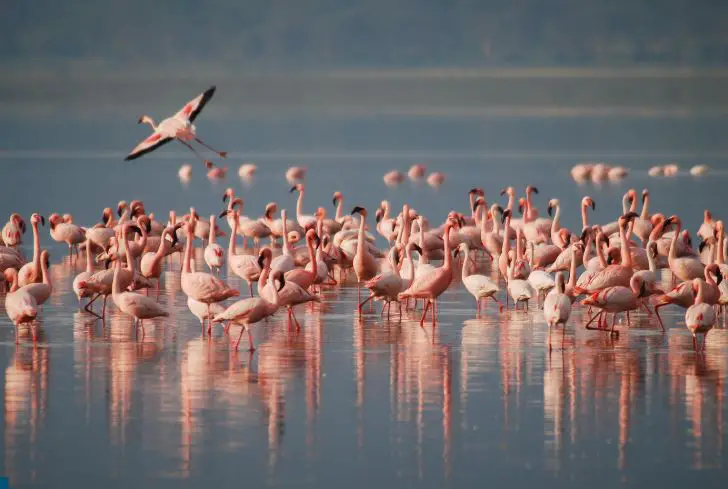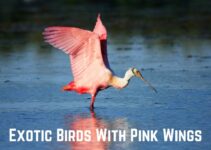Flamingos are rare creatures that people know little about. Just as pink is an atypical color to see in Earth’s fauna, flamingos are only located in the tropical and subtropical areas of the world – particularly on the coasts of Africa and Southern America. They prefer temperatures around 25°-27° C, so rainy places are their ideal habitats.
So, do flamingos live in the rainforest only? We have researched and found all the important facts you need to know about where flamingos live in this article!
Contents
Do Flamingos Live in the Rainforest?
Flamingos live in the rainforest as they prefer to live in tropical and subtropical areas with wet and cooler temperatures and heavy rainfalls. They are also not centered in the middle of the rainforests, but rather at the edges, where usually water is located.
Since they are waterbirds, they prefer to be close to lakes and estuaries rather than in the middle of trees. For instance, you will find two common flamingo varieties, Andean and Puna residing in the area where the Andeans meets with the Amazon rainforest.
Apart from thick rainforests like the Amazon, you will find these birds around Africa, the Middle East, the Indian subcontinent, and southern Europe.
Where Do Flamingos Live?
Tropical and subtropical environments are ideal for flamingos. They like to hang out in mangrove swamps, sandy islands, and shallow lakes. These birds exclusively inhabit certain regions with wet ecosystems from fresh to saltwater due to their nutrition. However, what’s intriguing is how adaptive these magnificent birds are.
They can be found in western Bolivia, northwestern Argentina, northeastern Chile, and southern Peru.
Andean flamingos can be found in western Bolivia, northwestern Argentina, northwestern Chile, and southern Peru.
Large flocks are more common in areas where flamingos can survive in brackish water where little food is available for other birds. In these situations, flamingos congregate in large numbers to take advantage of the plentiful food with little competition.
What Do Flamingos Eat?
The pink or reddish color of a flamingo’s feathers, legs, and face are the results of a diet rich in alpha and beta carotenoid pigments, especially canthaxanthin. The majority of a flamingo’s diet is made up of diverse crustaceans and algae, which are the richest sources of carotenoids.
The primary foods consumed by flamingos include blue-green and red algae, diatoms, microscopic insects in their larval and adult stages, crustaceans, mollusks, and small fish.
Lesser flamingos consume about 60 g of dry weight each day to meet their nutritional needs.
Researchers found that these birds push water through their bills 20 times per second to filter their food through slow-motion photography. The Caribbean flamingos were found to filter their daily food requirements of 270 g dry weight at a substantially slower rate—only 4–5 times per second.
Flamingos drop their necks while standing in shallow water and lean their heads slightly backward so that their bills hang backward in the water. If they have a deep-keeled mandible, flamingos sweep their heads side to side just below the water’s surface to capture their prey.
A flamingo will swoop its head from side to side deeper into the mud to gather food if its mandible is shallow-keeled.
How Many Varieties of Flamingos are There?
The Phoenicopteridae family of birds solely includes flamingos, which make up all of its members. Aside from ducks, geese, grebes, and even doves and sandgrouse, their nearest cousins are ibises and spoonbills. These birds are distinguished by having exceptionally long, slender necks and legs.
Although they have relatively small heads, they have huge, heavy bills with a recognizable crook or break. Young flamingos have straight bills, but as they become older, the break appears.
There are six flamingo species like the greater flamingo, lesser flamingo, Chilean flamingo, Andean flamingo, Caribbean flamingo, and puna flamingo.
The greater flamingo is the largest and most common species in the flamingo genus. It can be found in southern Europe, the Middle East, the Indian subcontinent, and Africa.
Meanwhile, the temperate region of South America, extending from Ecuador and Peru to Chile and Argentina and east to Brazil, is home to Chilean flamingos.
Additionally, Chilean flamingo colonies have been established in Germany, the Netherlands, Utah, and California as well. Eastern and southern Africa are the main locations where you can find lesser flamingos. Smaller populations do survive in Yemen, Pakistan, India, Yemen, western Africa, and Madagascar.
While, Caribbean flamingos can be found on various Caribbean islands, the Yucatan Peninsula in Mexico, and the north coast of South America. This Andean flamingo species is unique to South America’s high Andes but Puna flamingos can also be found in these regions.
Why are Flamingos So Pink?
Even though flamingos are recognized for their pink feathers, not all of them are that color. The carotenoid pigments in the birds’ food are what give them their pink color. Carotenoids give ripe tomatoes their red color and give carrots their orange hue. Additionally, they are present in the microscopic algae that brine shrimp consume.
A flamingo’s body breaks down the pigments in algae and brine shrimp while it eats, coloring the feathers pink.
Flamingos that consume a diet deficient in certain pigments will instead be grey or white. These birds may also have orange feathers, and many flamingos have some black on their wings, depending on what they consume.
Can Flamingos Fly?
Flamingos prefer to fly, but at very high altitudes and have the ability to travel great distances, in contrast to many other birds who spend most of their time on the ground. Flamingos may travel 375 miles in a single night, traveling at an average speed of 35 mph and reaching altitudes of 15,000 feet.
All of this is to suggest that although flamingos spend most of their lives on the ground and in the water, they are capable of long, sustained flight at high speeds. You might be asking why we hardly ever see flamingos in the air given that we see them virtually exclusively on the ground.
The reason is that they frequently soar to altitudes of 10,000 feet or higher, and at that distance, their pink or red colors are difficult to see in the sky. You may have gazed directly at a flock of flying flamingos and failed to see them, depending on where you live.
Even though they are not a true migratory species, flamingos still fly quite a bit. Changes in the weather, the level of the water, or the availability of food will cause them to move.
Although not migrations in the conventional sense, these occur regularly. Flamingos love shallow water and dislike particularly cold temperatures.

Flamingo: Habitat, Migration, Feeding, Nest
1. Habitat
Visit the appropriate locations where these wading birds live if you want to view wild flamingos. Flamingos can be found in a variety of freshwater and saltwater wet habitats, including mudflats, lakes, coastal lagoons, open marshes, and relatively shallow salt lakes.
Large flocks are more common in areas where flamingos can survive in brackish water where little food is available for other birds. In these situations, flamingos congregate in large numbers to take advantage of the plentiful food with little competition.
Flamingos are found in the Caribbean, South America, Africa, the Middle East, and near the Mediterranean. Different species of Flamingos reside in different parts of the world.
2. Migration
In general, flamingos do not migrate. However, flamingo colonies are not always stable because of variations in the temperature and water levels in their nesting grounds. When high-altitude lakes freeze over in the winter, populations that breed there migrate to warmer regions.
Birds may look for better locations as the water level rises. Some flamingo populations may be forced to move due to drought conditions. Most flamingos that migrate will go back to reproduce in their original colony. Some, nevertheless, might decide to go to a nearby colony.
When Flamingos do migrate, they tend to do so at night only. The majority of flamingos that leave the colony migrated to Spain in the southwest or Tunisia and Turkey in the southeast to spend the winter.
The direction of the dominant winds during the birds’ first autumn appears to affect the proportion of birds that migrate east or west.
3. Feeding
The primary foods consumed by flamingos include blue-green and red algae, diatoms, microscopic insects in their larval and adult stages, crustaceans, mollusks, and small fish. A flamingo’s diet is determined by the form of its filtering bill. A flamingo’s bill will either be shallowly or deeply keeled.
Deep-keeled bills and algae and diatoms are the principal sources of food for lesser, puna, and Andean flamingos. The shallow-keeled bills of greater, Caribbean, and Chilean flamingos let them graze on water invertebrates, tiny fish, and insects.
The primary diet of Caribbean flamingos consists of brine shrimp and fly larvae and pupae. Small variations in diet and behavior between flamingos that share feeding grounds preclude competition.
A flamingo’s spiny, piston-like tongue helps it suction food-filled water past the lamellae inside its curved bill as it filters its food out of the water and muck. Food is removed via the fringed lamellae, and water is returned to the bill.
Lamellae additionally eliminate meals that might be too big or small for the flamingo in addition to filtering food into the bill. Flamingos may stamp their webbed feet while standing in water to stir up food from the bottom.
4. Nest
Along waterways, flamingos erect nests that resemble mud puddles. The female lays one egg in a little hole at the top of the mound. To keep the egg warm, the parents alternately sit on it. Approximately 30 days later, the egg hatches.
Can a Flamingo Be a Pet?
A flamingo cannot be kept as a pet or kept as an individual without permission from the appropriate authorities. The Migratory Bird Act protects flamingos, so you must possess a specific license to keep one. Flamingos are wild animals, which is another reason why they make bad pets.
They may act wild even though you have raised them since they were little since it is already ingrained in their nature. They’ll always be instinctively wild. Another reason would be that Flamingos are expensive and their needs are expensive as well.
Flamingos are care-intensive pets that require a lot of attention. You require a sizable cage, a sizable sum of money for their nutrition and vitamins, and still more cash for the permit. You will have to keep two flamingos, therefore it is costly. Being gregarious creatures, flamingos require a mate.
Therefore, you must purchase two flamingos and care for two flamingos. Flamingos are after all birds and to strip them of their ability to fly and move around freely would not be the ideal scenario for this species.
Final Thoughts
Concluding the article, flamingos do live in the rainforest but are not located there solely. Thankfully, instead of going to water bodies to spot these rare creatures, you can find them in the natural biospheres and preserves if you ever want to see them.
We hope that this article has helped answer your questions about flamingos.







